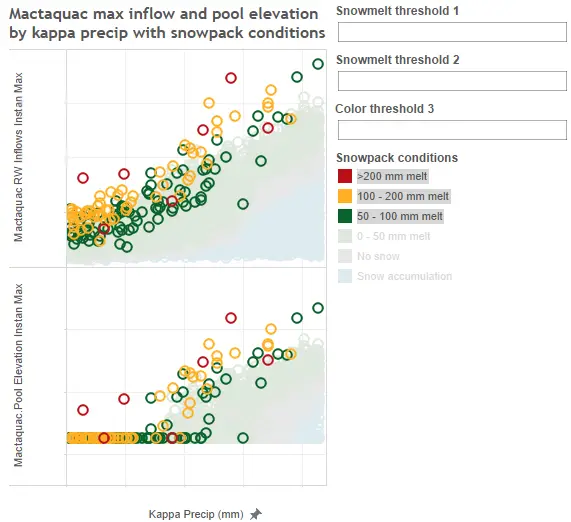Comprehensive Analysis Shows the Benefits of Assessing Dam Risk
Objective
To help New Brunswick Power choose among several options for repairing an aging dam.
Approach
We used leading methods and models to complete a three-phase risk analysis.
Impact
The client used our analysis to form a remediation plan and move ahead with measures that protect the surrounding population.
The Mactaquac Dam has been an important source of electricity in New Brunswick, Canada, since 1968. Over the years, its concrete form has begun to degrade from an Alkali-aggregate reaction. A failure would threaten lives and livelihoods throughout the province.
To protect the dam and the surrounding area, owner New Brunswick Power (NB Power) recently took corrective action, working with RTI and other partners to evaluate several options. These included stabilizing the concrete, rebuilding the structure, removing only the powerhouse section, or completely removing the dam. Each potential path came with its own benefits, challenges, and costs.
Phase I Risk Assessment Support
In support of NB Power’s decision-making process and in coordination with Kleinschmidt Associates, RTI developed a multi-criteria decision analysis (MCDA) support tool. With this approach, a series of criteria and sub-criteria are defined, which includes both quantitative values (e.g. costs, carbon emissions, impact areas) and qualitative metrics (e.g. social implications, recreational opportunities, etc.). Studies and expert knowledge are used to quantify values for each metric for all alternatives. Secondly, through a stakeholder engagement and elicitation process, we obtained a relative ranking of preferences for each criterion, allowing disparate groups to express varying levels of preference.
Once this information was captured and input into the MCDA, we used two different methods, Weighted Average and Promethee-II, to develop composite scores for each alternative and for each stakeholder preference group.
This process allowed NB Power to assess the alternatives in an unbiased, documented, and fully transparent method to help support internal and external dialogues of tradeoffs. Since this study, NB Power has moved forward with remediation activities.
Phase II Risk Assessment Support
RTI was tasked with developing consequence information for multiple hypothetical Mactaquac Dam failure scenarios. This analysis supported the Phase II Mactaquac Dam Risk Assessment and was performed in close conjunction with a hydraulics analysis performed by Stantec and the risk assessment performed by RAC Engineering. The hydraulic model results inform the consequences results, which are a critical piece of risk analysis, making coordination essential.
For the analysis, the United States Army Corps of Engineers (USACE) Hydrologic Engineering Center Flood Impact Analysis (HEC-FIA) model was used. In addition to the HEC-FIA model development, RTI developed Geographic Information System (GIS) input layers to support the analysis, including a building points dataset that was digitized for the entire study area. Population was estimated between day and night exposure cases based on Statistics Canada datasets. The population used in the analysis accounted for a percentage of residents leaving their house to work in commercial structures during the daytime hours, which was based on employment statistics for the region. The USACE Elicitation of Experts interview process was implemented to determine the length of time associated with the flood and dam breach warning issuance process, to estimate when population would receive a warning, and to estimate how long it would take them to begin to take protective action. The model results were implemented in the Phase II risk analysis and were used to determine if a more comprehensive study was justified.
Phase III Risk Assessment Support
RTI worked with New Brunswick Power, Stantec, MGS Engineering, MetStat and RAC Engineers to complete a comprehensive risk assessment for Mactaquac Dam. RTI is serving many roles in the project including performing stochastic hydrologic simulations and developing consequences models.
The hydrologic hazards analysis included calibration of SNOW-17, SAC-SMA, and LagK hydrologic models of the watershed and development of a RiverWare reservoir operations model to simulate the dam operations of Mactaquac Dam and upstream reservoirs in response to flood events. These components were incorporated into the Stochastic Event Flood Model framework (SEFM, developed by MGS Engineering) to simulate thousands of synthetic events and compute annual exceedance probability curves that depict the frequency of particular reservoir elevations at Mactaquac dam. As a part of the analysis, RTI developed a synthetic weather generator to support evaluation of the impacts of extreme snow accumulation and rain-on-snow events on hydrologic hazards. The analysis also considers gate reliability and upstream dam failures in the simulation process. The process includes a parameter sensitivity investigation and uncertainty analysis to quantify the uncertainty in the resulting hydrologic hazard curves.
Under this project, RTI is also updating the original Phase II consequences modeling completed by RTI to support the risk analysis using the U.S. Army Corps of Engineers Hydrologic Engineering Center’s LifeSim (HEC-LifeSim) software. RTI is conducting additional interviews with downstream emergency officials to improve the understanding of warning dissemination and evacuation. The HEC-LifeSim model simulates the flood and breach scenarios required for the Phase III risk analysis. Local road networks are included in the model to depict the evacuation of the population at risk. This consequence analysis also considers uncertainty on warning time, warning dissemination, and mobilization, among other parameters.
Learn more about our risk assessment services and the RTI Rapid Risk Suite to see how we can support your organization.
- New Brunswick Power


